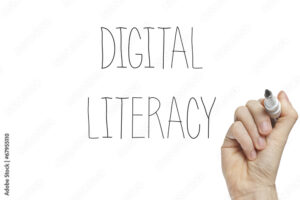Digital Literacy in the Primary Grades
As I am an early elementary teacher, I will have the important task of introducing students to digital literacy and laying the framework for being safe and productive while using digital technologies. Teaching digital literacy at this age will include lots of preemptive class conversations about technology and media.

When beginning to teach digital literacy, I think it is important to gauge where your students are at with technology. Some fourth graders do not have access to technology and the internet, while lots do and are already active on social media accounts. This could be done by a jot form, paper survey, or a menti meter. I would most likely conduct this anonymously to ensure student privacy.
Once I know where my students are at, I would begin forming lessons on online safety and etiquette. I would explain why this is crucial, and talk briefly about the dangers of improper online usage (cyber bullying, abuse) and strategies to avoid falling prey to these dangers. (utilizing account privacy settings, not talking to strangers, not posting public information/photos of yourself). When teaching about how to know if a resource is real vs fake, I would introduce the acronym “IMVAIN” from the article Teaching Information Literacy Now. This provides students with some critical questions they can ask when determining the credibility of a source. As I teach younger students, I would definitely take the time to break down each step and model how I would use it to check credibility.
- Is the material Independent or self-interested?
- Does it have Multiple sources or only one?
- Does it Verify, or assert?
- Is it Authoritative/Informed vs. uninformed?
- Are sources Named or unnamed?
I would tie this teaching into my health units. Here’s an example of an outcome from the grade 4 Saskatchewan Health Curriculum that focuses on digital literacy.
USC4.4
Determine basic personal responsibility for safety and protection in various environments/situations.
Indicators:
| b | Explore critical safety needs (e.g., cyber, hunting, water, fire, biking) of self and others in local community. |
| d | Examine cyber safety etiquette and related safety risks and strategies. |
| j | Examine one’s responsibility to use electronic networks in an ethical and safe manner. |
In the weekly plans there were lots of great tools and resources posted for teaching digital literacy and safety to students. As I am a primary teacher, I think the interactive activities where students can spot the fake news, profile, or headline would be a great introduction to being critical about the content we see while online. Spot The Fake News Headline, Break The Fake, and Spot The Troll are some resources I would use with the whole class to teach about strategies for spotting fake accounts and information. They all are very engaging and I am sure students would enjoy taking part in them! This could also be a way for students to practice using the “IMVAIN” acronym from Teaching Information Literacy Now.